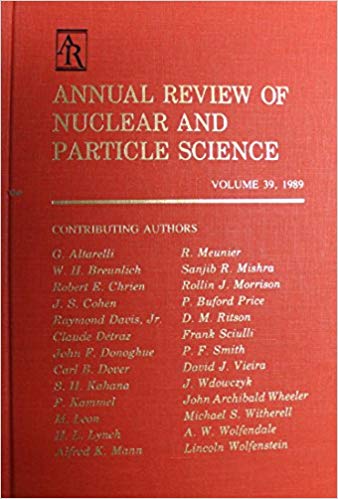Sidney David Drell (September 13, 1926–December 21, 2016): A Biographical Memoir
IF 8.4
2区 物理与天体物理
Q1 PHYSICS, NUCLEAR
Annual Review of Nuclear and Particle Science
Pub Date : 2019-10-21
DOI:10.1146/annurev-nucl-020619-120837
引用次数: 0
Abstract
Sidney David Drell, professor emeritus at Stanford University and senior fellow at the Hoover Institution, died shortly after his 90th birthday in Palo Alto, California. In a career spanning nearly 70 years, Sid—as he was universally known—achieved prominence as a theoretical physicist, public servant, and humanitarian. Sid contributed incisively to our understanding of the electromagnetic properties of matter. He created the theory group at the Stanford Linear Accelerator Center (SLAC) and led it through the most creative period in elementary particle physics. The Drell-Yan mechanism is the process through which many particles of the Standard Model, including the famous Higgs boson, were discovered. Sid advised Presidents and Cabinet Members on matters ranging from nuclear weapons to intelligence, speaking truth to power but with keen insight for offering politically effective advice. His special friendships with Wolfgang (Pief) Panofsky, Andrei Sakharov, and George Shultz highlighted his work at the interface between science and human affairs. He advocated widely for the intellectual freedom of scientists and in his later years campaigned tirelessly to rid the world of nuclear weapons.西德尼·大卫·德雷尔(1926年9月13日- 2016年12月21日):传记回忆录
斯坦福大学名誉教授、胡佛研究所高级研究员西德尼·大卫·德瑞尔在加州帕洛阿尔托度过90岁生日后不久去世。在长达近70年的职业生涯中,大家都知道sid是一位杰出的理论物理学家、公务员和人道主义者。席德对我们理解物质的电磁特性作出了深刻的贡献。他在斯坦福直线加速器中心(SLAC)创建了理论小组,并带领它度过了基本粒子物理学中最具创造性的时期。Drell-Yan机制是标准模型中许多粒子,包括著名的希格斯玻色子被发现的过程。席德为总统和内阁成员提供从核武器到情报等各种问题的建议,他对权力直言不讳,但又具有敏锐的洞察力,能够提供有效的政治建议。他与沃尔夫冈·帕诺夫斯基、安德烈·萨哈罗夫和乔治·舒尔茨的特殊友谊突出了他在科学与人类事务之间的界面上的工作。他广泛倡导科学家的知识自由,并在晚年孜孜不倦地为消除世界上的核武器而奔走。
本文章由计算机程序翻译,如有差异,请以英文原文为准。
求助全文
约1分钟内获得全文
求助全文
来源期刊
CiteScore
21.50
自引率
0.80%
发文量
18
期刊介绍:
The Annual Review of Nuclear and Particle Science is a publication that has been available since 1952. It focuses on various aspects of nuclear and particle science, including both theoretical and experimental developments. The journal covers topics such as nuclear structure, heavy ion interactions, oscillations observed in solar and atmospheric neutrinos, the physics of heavy quarks, the impact of particle and nuclear physics on astroparticle physics, and recent advancements in accelerator design and instrumentation.
One significant recent change in the journal is the conversion of its current volume from gated to open access. This conversion was made possible through Annual Reviews' Subscribe to Open program. As a result, all articles published in the current volume are now freely available to the public under a CC BY license. This change allows for greater accessibility and dissemination of research in the field of nuclear and particle science.

 求助内容:
求助内容: 应助结果提醒方式:
应助结果提醒方式:


